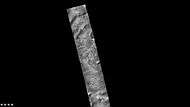Liais (crater)
Liais is an impact crater in the Mare Australe quadrangle of Mars, located at 75.4°S latitude and 252.8°W longitude. It measures 132.0 kilometers in diameter and was named after Emmanuel Liais. The name was approved in 1973, by the International Astronomical Union (IAU) Working Group for Planetary System Nomenclature (WGPSN).[1]
Liais Crater displays layers on its floor. Many places on Mars show rocks arranged in layers. The study of layering on Mars greatly expanded when the Mars Global Surveyor sent back images.[2][3] Rock can form layers in a variety of ways. Volcanoes, wind, or water can produce layers.[4][5][6] A detailed discussion of layering with many Martian examples can be found in Sedimentary Geology of Mars.[7] A paper by Grotzinger and Milliken discusses the role of water and wind in forming layers of sedimentary rocks.[8]
 Liais (crater), as seen by CTX camera (on Mars Reconnaissance Orbiter).
Liais (crater), as seen by CTX camera (on Mars Reconnaissance Orbiter). Layers is Liais crater, as seen by CTX camera (on Mars Reconnaissance Orbiter). Note: this is an enlargement of the previous image of Liais crater.
Layers is Liais crater, as seen by CTX camera (on Mars Reconnaissance Orbiter). Note: this is an enlargement of the previous image of Liais crater.
See also
References
- "Gazetteer of Planetary Nomenclature | Liais". usgs.gov. International Astronomical Union. Retrieved 4 March 2015.
- http://www.geo.brown.edu/research/Milliken/GEOL2920C_files/Week04_Summary_Jawin.pdf
- Malin, M. C., & Edgett, K. S. (2000). Sedimentary Rocks of Early Mars. Science, 290(5498), 1927–1937
- https://science.nasa.gov/science-news/science-at-nasa/2000/ast04dec_2.
- https://science.nasa.gov/science-news/science-at-nasa/2001/ast23jan_1/
- "HiRISE | High Resolution Imaging Science Experiment". Hirise.lpl.arizona.edu?psp_008437_1750. Retrieved 2012-08-04.
- Grotzinger, J. and R. Milliken (eds.). 2012. Sedimentary Geology of Mars. SEPM.
- Grotzinger, J.P. and R.E. Milliken (2012). The sedimentary rock record of Mars: Distribution, origins, and global stratigraphy, SEPM Special Publication, 102, 1-48.
Recommended reading
- Grotzinger, J. and R. Milliken (eds.). 2012. Sedimentary Geology of Mars. SEPM.